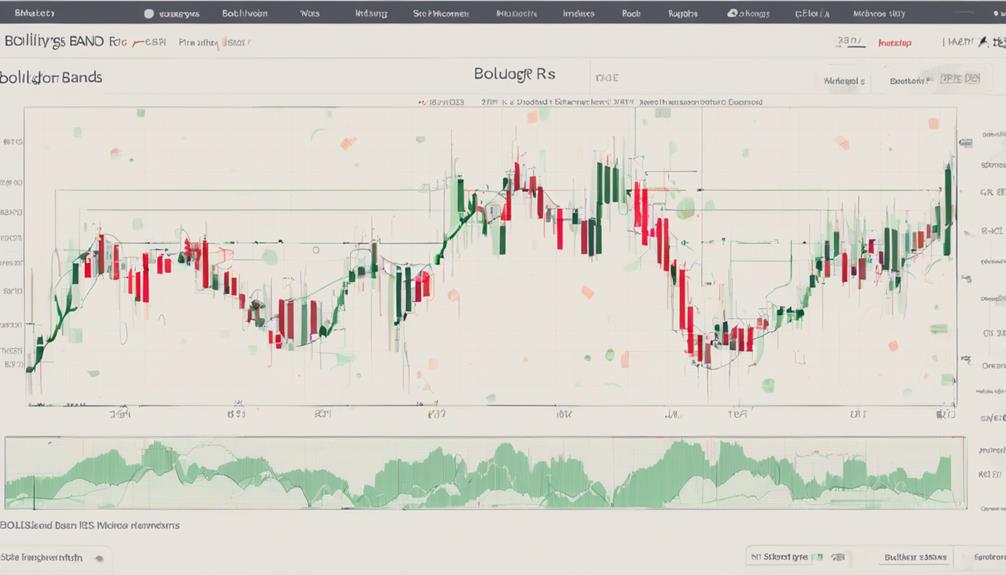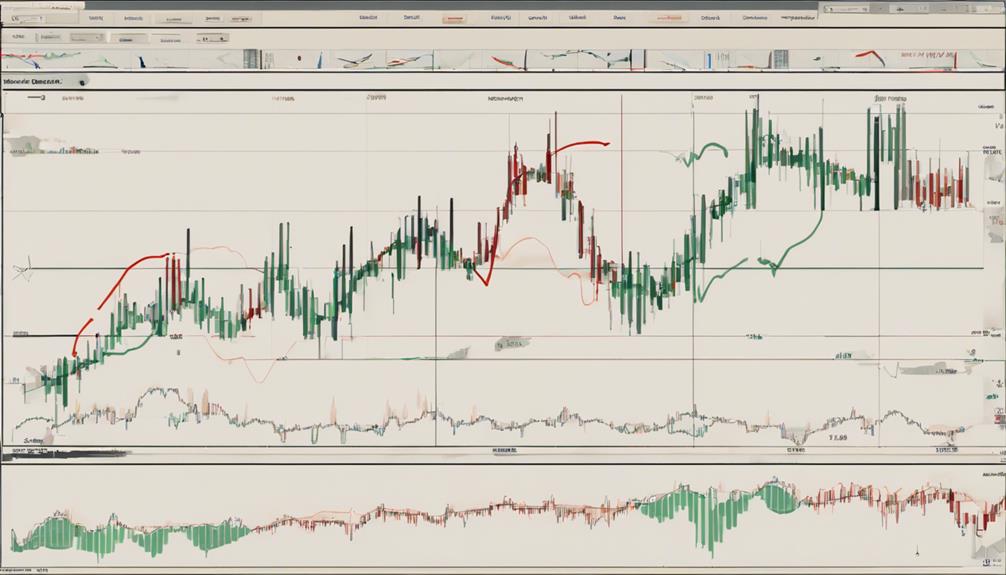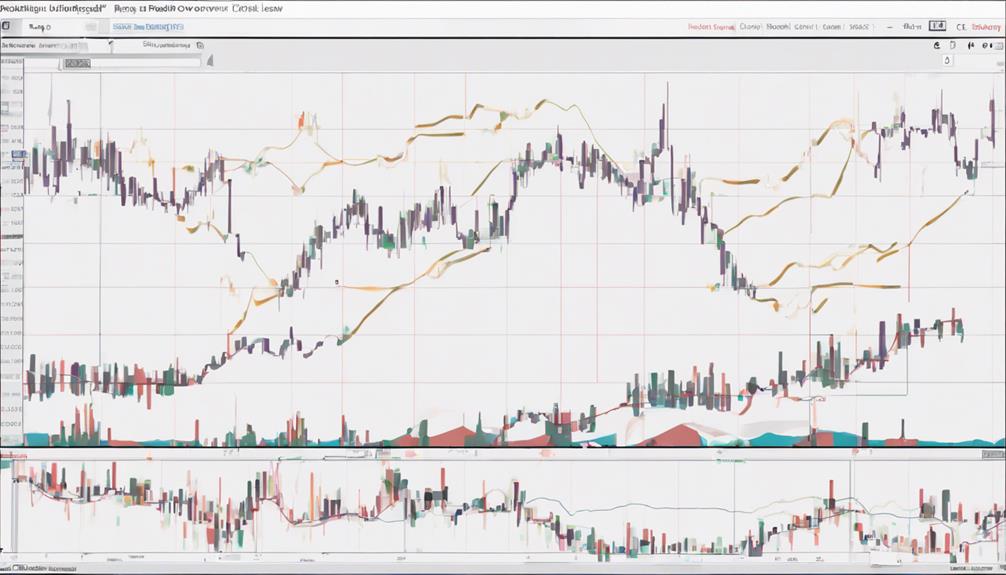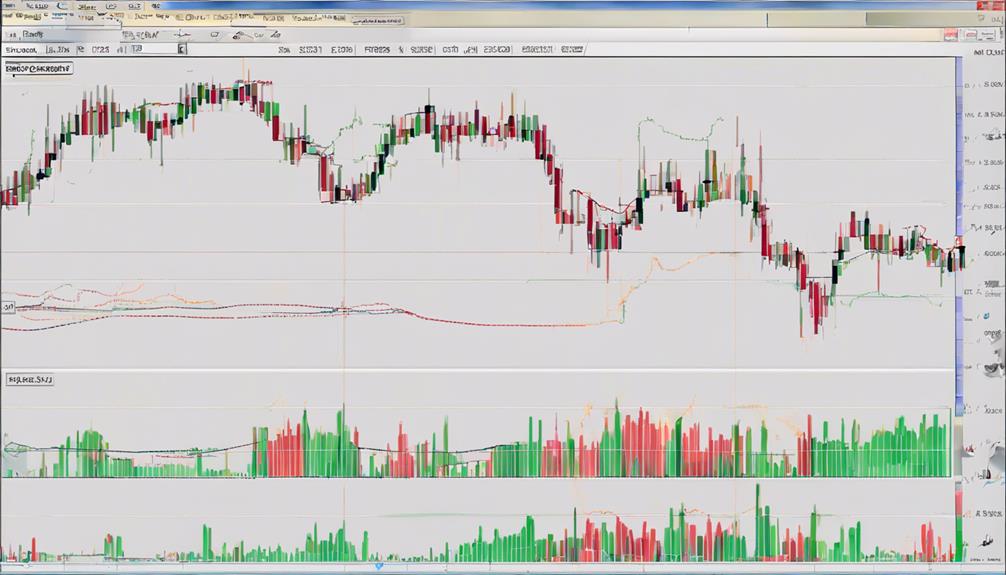The collaboration between Bollinger Bands and RSI enhances market analysis by combining volatility and momentum indicators. RSI evaluates price momentum and overbought/oversold conditions, while Bollinger Bands indicate price volatility and potential trend reversals. When integrated, traders can focus on RSI breaches of Bollinger Bands for trend reversal signals or buying opportunities when the bands touch. This synergy helps identify trend shifts and breakouts effectively. For a thorough market view, assess the width of Bollinger Bands alongside RSI signals. This integration optimizes trading strategies and risk management practices. Uncover the benefits of this partnership for strategic decision-making.
RSI Calculation and Interpretation
To conclude, evaluating the Relative Strength Index (RSI) provides valuable insights into market conditions and assists traders in making informed decisions based on price dynamics and momentum.
The RSI is calculated using the formula RSI = 100 – (100 / (1 + RS)), where RS represents the average gain divided by the average loss over a specified period. RSI values range from 0 to 100, with readings above 70 suggesting overbought conditions and readings below 30 indicating oversold conditions.
Developed by J. Welles Wilder in 1978, this indicator is a crucial element of technical analysis. Acting as a momentum oscillator, the RSI helps traders assess the speed and magnitude of price movements. By identifying market extremes, the RSI aids in evaluating both price momentum and volatility.
Traders use the RSI to validate the strength of trends and anticipate potential shifts in price direction based on overbought and oversold conditions. Ultimately, the Relative Strength Index is an essential tool in technical analysis for interpreting market conditions and making well-founded trading decisions based on price dynamics and momentum.
Bollinger Bands Calculation and Usage

Utilizing the middle band calculated as a 20-day Simple Moving Average (SMA) with upper and lower bands positioned at two standard deviations away, Bollinger Bands serve as a valuable tool for identifying price volatility and potential breakouts in the market. The bands dynamically adjust to price movements, expanding during volatile periods and contracting during calmer times. This adaptability makes them effective volatility indicators. Traders often use Bollinger Bands in conjunction with other technical tools like the Relative Strength Index (RSI) to gain a more thorough view of the market. Below is a table summarizing key points about Bollinger Bands and RSI:
| Bollinger Bands | RSI |
|---|---|
| Volatility indicators | Momentum oscillator |
| Upper band signals | Overbought conditions |
| Lower band signals | Oversold conditions |
Integrating RSI With Bollinger Bands

When combining the Relative Strength Index (RSI) with Bollinger Bands, attention should be focused on identifying instances where the RSI breaches the Bollinger Bands, signaling potential market extremes. Traders can utilize the upper Bollinger Band touches along with RSI readings to gauge potential trend reversal indications. Conversely, lower Bollinger Band touches paired with RSI can highlight buying opportunities in the market.
By integrating RSI with Bollinger Bands, traders can effectively identify trend reversals, breakouts, and make informed decisions based on both momentum and volatility indicators. It is essential to assess the width of the Bollinger Bands to evaluate the level of volatility in the market accurately.
This integrated approach provides a thorough view of market conditions and enhances the ability to capitalize on various trading opportunities, ranging from identifying potential market extremes to pinpointing optimal entry points for trades.
Trading Strategies With RSI and Bollinger Bands

Exploring the synergies between the Relative Strength Index (RSI) and Bollinger Bands reveals advanced trading strategies that leverage both momentum and volatility indicators effectively. By combining RSI with Bollinger Bands, traders can identify potential market extremes with more precision. Upper Bollinger Band touches coupled with RSI readings can offer valuable insights into potential reversal signals, indicating possible overbought conditions. Conversely, lower Bollinger Band touches in conjunction with RSI can signal potential buying opportunities, suggesting oversold market conditions.
Integrating Bollinger Bands and RSI enables traders to pinpoint trend reversals and breakouts more accurately. Utilizing these indicators together provides a detailed analysis of market dynamics, allowing for more informed trading decisions. By incorporating Bollinger Band strategies into RSI analysis, traders can develop a more nuanced understanding of market conditions and enhance their ability to identify profitable entry and exit points. These trading strategies empower traders to act decisively and strategically in response to changing market trends.
Risk Management With RSI and Bollinger Bands

To guarantee risk management in trading practices, integrating the Relative Strength Index (RSI) and Bollinger Bands offers a holistic approach that combines volatility analysis with momentum indicators. When using Bollinger Bands, traders can set stop loss positions based on market volatility, providing a structured way to manage risks. The RSI, on the other hand, can be employed to confirm or reject these stop loss positions identified by Bollinger Bands. By combining these two technical analysis tools, traders can establish more precise risk management strategies that consider both market volatility and momentum.
In addition to setting stop loss levels using Bollinger Bands and RSI, traders can also utilize Moving Averages and support/resistance levels to enhance trade safety. It is essential to backtest stop loss strategies before live trading to validate their effectiveness in protecting positions from adverse market movements. This thorough approach helps traders in identifying potential false signals and refining their entry and exit points for improved risk management in trading scenarios.
What is the Relationship Between Bollinger Bands and RSI in Trading Strategies?
Bollinger Bands and RSI are commonly used to enhance trading with indicators. Bollinger Bands provide information about the volatility of a stock, while RSI indicates overbought or oversold conditions. Together, they can help traders identify potential entry and exit points, as well as confirm trend reversals.
Frequently Asked Questions
Which Indicator Is Best for Combine With Bollinger Bands?
When considering indicators to combine with Bollinger Bands for technical analysis, traders often assess the compatibility of each indicator with Bollinger Bands' volatility signals.
Popular choices like the Moving Average Convergence Divergence (MACD) or Stochastic Oscillator can complement Bollinger Bands by providing additional insights into market trends and potential reversals.
Understanding how these indicators interact with Bollinger Bands can enhance traders' analysis of price movements and market conditions.
What Is the Best Indicator to Pair With Rsi?
Among indicators complementing RSI, the Stochastic oscillator stands out for its ability to identify overbought and oversold conditions. Its oscillating nature provides a valuable perspective on price momentum, enhancing RSI's insights.
Which Is Better, RSI or Bollinger Bands?
When comparing RSI and Bollinger Bands, it is important to acknowledge their distinct advantages and limitations.
RSI excels in identifying overbought or oversold conditions, while Bollinger Bands are effective in visualizing price volatility and potential breakouts.
RSI strategies often focus on momentum, while Bollinger Bands tactics aim to capture price fluctuations.
Understanding the strengths and weaknesses of each indicator is vital in making informed trading decisions.
What Works Well With Bollinger Bands?
When working with Bollinger Bands, moving averages play an essential role in understanding price action and trend analysis.
Additionally, volume spikes, support resistance levels, market volatility, and candlestick patterns provide valuable insights for traders.
Incorporating Fibonacci retracement, oscillator divergence, and MACD crossovers further enhances the technical analysis toolkit for making informed trading decisions.
Conclusion
To sum up, the integration of RSI and Bollinger Bands can provide traders with valuable insights into market trends and potential price movements. By combining these two technical indicators, traders can develop effective trading strategies and manage risks more efficiently.
For example, a hypothetical scenario could involve using RSI to identify overbought or oversold conditions in conjunction with Bollinger Bands to confirm potential trend reversals, leading to profitable trading opportunities.
